INFORMATICS IN ANESTHESIA - Development of an anesthesia
informatization project to introduce the computer in the daily
practice
V. LANZA ,MD
Chief of Anesthesia, Department of
Anesthesia - Ospedale Buccheri La Ferla, Fatebenefratelli -Via
Messina Marine 197, 90123 Palermo, Italy
The recording of anesthesiological
data on a computer has been the subject of studies for quite a
few years. Anesthesiological records, in fact, present certain
peculiarities which do not adapt themselves too well to an
informatic transition, such as that of the archivation of a large
amount of data in the moment they are produced.
It is not, in fact, feasible to
register on a computer the parameters and therapies practised by
the anesthesist subsequently, without having the use of a
manually written record compiled during anesthesia in the exact
moment they are obtained. This choise would necessitate the
filling-in manually of clinical records; a procedure which would
go against the normal hospital structures.
On the other hand it would be easy
to imagine the advantages of anesthesiological computerised
records when there is the need to obtain a speedy and faithful
documentation of such a delicate event as that of the
anesthesiological procedure of the doctor and the responses of
the patient during surgery.
Taking all this into consideration
in the 1985 at Buccheri La Ferla Hospital (B.L.F.H.) anaesthesia
department an informatization project started. The guidelines of
this project were:
1) a compilation as near as
possible true to the manually written records
2) a possibility to fill in data
in real time during the anesthesiological visit and during
anesthesia itself
3) the use of low cost personal
computers
The software design and the codes
was written by an anaesthesiologist (the author of this article)
according to these main features:
Overlay tecnique
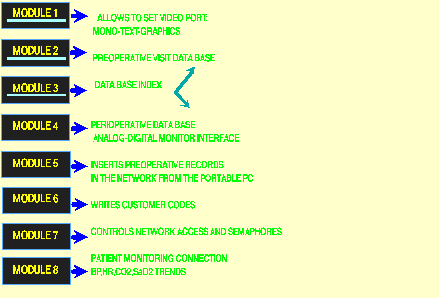 |
FIG.1
WORKSTATION SOFTWARE STRUCTURE. The software was a collection of modules.
Only the needed modules are loaded in the RAM according
to enviroment activity.(i.e. preoperative visit,anesthesia,etc.).This
permits to use a small PC (subnotebook) to perfom the
preoperative visit at patient's bed.
|
Codes (FIG.2)
 |
FIGURE 2 Codes tables
|
The program uses codes extensively.
Codes tables are customised by the user. This task permits an
English (or other country) workstation to read an italian record
sheet. In fact an italian anesthetist uses "76" to
write "cuore". The computer records "76", an
English customised table workstation can read heart.
This task allows the exportability
of the anesthetic procedures saving disk space.
Secrecy of data
The access to the programm is only
obtained if a special file is found in diskette sited in drive A.
Safety to record
anesthesiological data
It is possible to set the interval
to automatic disk storage. This feature is very important to
prevent an electrical failure to lose data.
Structure of the Clinical
Record Sheet
This record sheet is made up of
two fundamental parts:
1) Pre-operative visit
2) Anesthesiological procedure
 |
FIG.3 Flowchart of user interface.
|
PREOPERATIVE VISIT
Loading a new patient:
A new progressive number will be
assigned and the data loading of the pre-operative visit will
begin:
Page 1, history of diseases
The combination of codes (35 max)
allows a fast compilation of the anesthesiological anamnesis;
while 70 characters can be typed on another field for the
insertion of other annotations.
Page 2, drug allergies
Eventual complications in previous
anesthetical sessions or allergies of which the patient could be
a carrier: first field in codes (20 max) , other three fields of
70 characters, one can also typed the drugs which have provoked
the complication or the allergy and the applied therapy.
Page 3, physical examination
The data referring to the visit of
the various apparatuses are reported (the body surface area is
calculated by the computer). The fields will accept codes or
alpha numerical characters for the description of reports of
eventual instrumental examinations. 140 characters are available
for annotations.
Page 4, laboratory tests
The hematochemical data, the
surgical diagnosis, eventual pre-operative prescriptions, the A.S.A.
classification of the operational risk, the date (entered by the
computer) and the name of the anesthesist can be entered.
Page 5, surgical diagnosis
The surgical diagnosis is reported.
The fields will accept codes and alpha numerical characters. It
is therefore possible to go back to the various pages already
entered or to display the entire visit, decoded and compacted .
From this video it is possible to
go back to the previous pages of the visit and modify them or to
input the patient into a file or go to the research section. The
latter allows for the access to the general index of the files
and therefore to the preoperative visit or to the
anesthesiological procedures.
ANESTHESIOLOGICAL PROCEDURES
This part includes 8 sections.
Page 1 PATIENT'S DATA: the
date of operation, the name of surgeons and anesthesists, type of
operation are entered
Page 2 PREMEDICATION: time,
drugs and doses of premedication are entered.
Arterial pressure: time,
the arterial pressure max values, min and heart rate are
transcribed, and at last 50 characters can be typed for other
annotations.
Page 3 LUMBAR ANESTHESIA:
the loading of data is similar to the premedication section. Time,
type and intervertebral space of the lumbar anesthesia (spinal,
epidural, sacral) performed and drugs utilised are entered.
Moreover the arterial pressures and a description of the
characteristics of the analgesia obtained (onset) can be entered.
The highest metameric level (for ex.: umbelical line =T10) the
lowest level (for ex. scrotum = S5), the onset of the analgesia
and the motor block , the type of needle and the catheter
diameter can be entered. Finally 40 characters are available for
eventual notes.
Page 4 PERIPHERIC
ANESTHESIA (other types besides the lumbar): input of data is the
same as page 3 except for the description of the type of
anesthesia applied without the use of codes but with
alphanumerical characters and the onset field in which it is
expected the insertion of the analgesia and motor block latency.
Page 5 ANESTHESIA INDUCTION:
the input of data follows the same modalities the previous pages
of peripheric anesthesia. Nevertheless on this page the onset
field is substituted by the ventilation field where the diameter
of the endotracheal tube used, the liter per min. of oxygen and
of the nitrous oxide (N2O) distributed, the high and low pressures
of the upon airways registered during ventilation and respiratory
frequency are entered.Eventual variations of the ventilation
parameters which can occur successively can be inputed on two
other fields. Finally 40 characters can be typed for eventual
annotations.
Page 6 SURGERY: in the
preceding pages the section that was recalled was preceded on the
video by the decodificated and compacted description of the
procedures already executed. In the section dedicated to the
surgery,in order to offer more space on the input of drugs and
phisiological parameters, only the data to identify the patient
is left on the video. (The preceding part of the anesthesia is
anyway visible with the procedure of the general impagination of
the menu). The initial time is recorded and also the temporal
value to attribute to each character of the line in respect to
the initial time. Once entered these parameters we can have
access to the surgery page. The surgery section allows the
recording in function of drug time, infusion etc. administered
from the moment of the incision and also the recording of the
monitorized vital parameters. 18 lines are available, the first 3
(maximum and minimum arterial pressure and heart rate) are
already there, the remainig can be inserted typing the code or
the name of the drug. After entering the name of the drug on the
same line is inserted the modality of the administration in
relation to the time. A second "operation" page with
the same characteristics can be created by the user.
Page 7 EVALUATION: the
first field is dedicated to the description in code of eventual
problems during the awakening. A field of 50 characters can be
inputed for other annotations. Another field in code for the
description of eventual problems that can arise during the post
operative period followed by another field of 50 characters.
Page 8 POST OPERATIVE
TREATMENT: the characteristics of this page are similar to the
surgery page. Once entered the starting time one can choose some
standard therapies to which one can add other drugs with the same
procedure described in the "surgery" section.
HELP: On line are also available help functions
to farmacological calculations and anesthesia administration, by
using <F8> key (fig.4).
An analitical search (i.e. drug
name) is also possible .
| &1.0 U=uso;D=dose;L=latenza;Du=durata;R=ridistrib.;E=emivita;F=effetti
farmac. |
| N=note;M=metab.El=eliminaz. |
| SINTODIAN U= nausea,vomito,agitazione,neurolept.
|
| D 1.25-10 mg |
| L 5-8 min Du= 3-6h |
| F sedazione,antiemesi,indiff.
ambiente N= ansia,reazioni extrapiram,ipoten- |
| sione,residui effetti > 24h |
| M fegato El= rene, fegato (10%
immodif. |
| FENTANEST U= dolore,induz.anest. |
| D (analg.periop.)10-100 mcg e.v.(100
mcg=10 mg morfina) |
| L 2 min Du=variab. R=1-2 min E=4 h |
| F analgesia,depres.SNC., euforia. N=possibile
depress.resp.,broncospasmo(ra- |
| ro),bradicardia,ipotensione,nausea,vomito,disforia,diaforesi,reaz.allerg.,re
|
| lease istamina, >press.biliare,
<motilita'gastroint.,passaggio transplacent. |
| M fegato El= rene(10-20% immodific. |
| VALIUM U= ansia,agitaz.,convuls.,spasmo,induz.sedaz.o
ipnosi. |
| D (sedaz.)0.05-0.15mg/Kg ogni 4h e.v./i.m.,
(ipnosi-induz.anest.gen.) |
| 0.1-0.5 mg/Kg,(convuls.)0.1mg/Kg |
| L e.v. rapida,i.m. 15-30 min D=e.v.
15 min-3h |
| El 7-10h;metab.attivi 2-8gg. |
| F depress.SNC,amnesia, >soglia
convuls. N= possibile ipotens., >ansia (idio |
| sincr.), psicosi, lieve depress.respir.,apnea
(raro), tromboflebite. Irri- |
| tante tissutale: i.m./e.v. iniezione
dolorosa. Possibili fenom. accumulo. |
| M Fegato (1/3 metab. attivi=oxazepam)
El= rene(70%). |
| F4=RICERCA,AvPg=Pagina seguente,RitPg=precedente,Esc=ritorno
al programma |
| FIGURE 4.
ANESTHESIOLOGICAL HELP ON LINE |
From the menu it is possible to
follow other procedures:
1) All data loaded in the various
sections can be entered in files and the program will return to
the section search by the number keeping in memory the number of
the patient entered.
2) All the loaded data can be
entered in files but the program continued the search per keys
previously started searching for another patient.
3) The operation is decoded and
displayed in compacted form
4) The preoperative visit of the
patient is displayed
5) Printing of the anesthesia
section is produced.
-
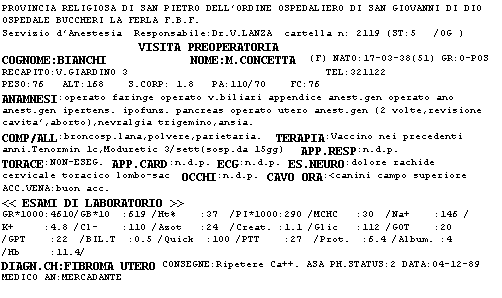 |
Fig.5 The recordsheet given to the
discharging patient.
Visit
|
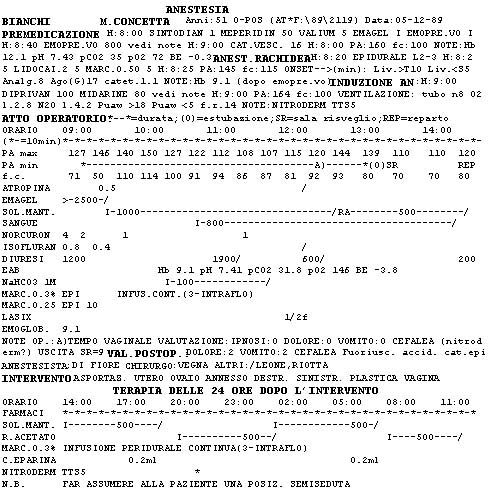 |
Anesthesia
procedures and postoperative teraphy |
RESEARCH SECTION:
The patient search could be
performed by either the number of the patient or by keys.
Search by keys: this
section allows the search of patients according to eight keys.
The video presents the following search keys:
1) "DATE OF VISIT":
- **-MM-YY (only the last two
digits of the year) all the patients visited in the month
requested.
- DD-MM-YY all the patients in the
requested day.
- It is possible to search from
one date to the other.
2) "DATA OF THE OPERATION":
same procedures of the field "DATE OF VISIT".
3) "LAST NAME", "NAME":
complete or partial data.
4) "BIRTH": search for
birthdate (DD-MM-YY) or for the age.
5) "SURGERY" search for
complete or partial data (with or without codes ). For example a
subject having gone through a colecystectomy can be searched by
typing: I02A14(complete) A14(partial).
It is possible to limit the search
to a length of defined characters limiting the field with "/".
For example to search for all the patients named LANZA without
searching all others whose last name begins with LANZA (such as
LANZAFAME, LANZARONE, etc.) search for LANZA/. This will avoid
the search of patients not asked for. The same procedure is
applicable on all specific searches.
6) MINIDISK: search for the
desidered years changing the year number included within the
slash those of the desidered year or else for all the registered
years starting from a determined year. We will have therefore
outputed the index data regarding the patient. It is therefore
possible the output of the anesthesiological data that can be
visualized with the same procedure as in the "Search by the
number".
PRINTING OPTION:
The program has available the
printing of data either in series or on single basis. The single
printing is available through the visit, search, anesthesia
sections while the series procedure is activated with the search
section. The types of printouts available are:
1) VISIT: printing of the visit
2) ANESTHESIA: printing of
anesthesiological procedures
3) VISIT + ANESTHESIA
4) POST OPERATIVE THERAPY
5) INDEX:printing of the index of
the patients, in other words, the fields outputed in the search
section (date of visit, date of operation, etc).In figure 5 is
showed the complete recordsheet given to the discharging patient
.
Development of
the anesthesia informatization project
The project was completed in
december 1986. In 1988 a new module that perfoms an automatic
serial connection (analog-digital optional) to patient monitor
system was added. This last feature completed the anaesthesia
workstation. Like an office workstation the anaesthesia
workstation is a collection of anaestesiological tools shared
between the components of the anaesthesia department. The B.L.F.H.
anaesthesia workstation provides:
1) A ten years patients data-base
with a preoperative and anaesthesia data form.
2) Vital signals automatic
collection and trend storage from patient monitoring by an analog-digital
conversion or serial communications.
3) On line available help to
farmacological calculations and anaesthesia administration
4) Network mail and data sharing
with other anaesthesia workstations.
- Automatic transfer to network
of preoperative visit collected at patient's bed with the
portable computers.
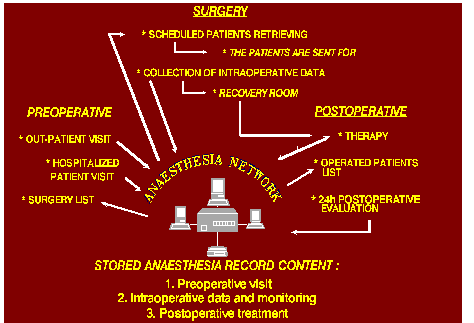 |
FIGURE 6 FLOWCHART
OF THE B.L.F.H. ANAESTHESIOLOGICAL ACTIVITY
|
The preoperative visits are
collected in real time by a portable PC at patient's bed or
during the out-patients visit. Then the anaesthesist transfers
the collected forms to the anaesthesia workstation network by
serial port communications or by a floppy diskette. A printed
surgery list with the anaesthesiological advise for the scheduled
patients is given to the ward the day before surgery. On surgery
day the anaesthesia nurse retrieves the scheduled patients from
the network, prints the surgery list with the preoperative
patient's form and disposes for the patients arrival. The
anaesthesist introduces the anaesthesiological procedure data, (premedication,
induction etc.) in real time by a PC workstation sited in the
Operating rooms while having corrently available the pre-operative
visit's data, on line anaesthesiological help and communications
facilities with the other anaestesists. Also the PC perfoms an
automatic data monitoring collection building a trend with a
minute resolution. In the recovery room the nurse writes on the
computer the procedures and the post-operative therapies wich are
printed depending on the actual procedures done by various
anaesthesists. Such therapies are then given to the particular
wards to which the patients belong.
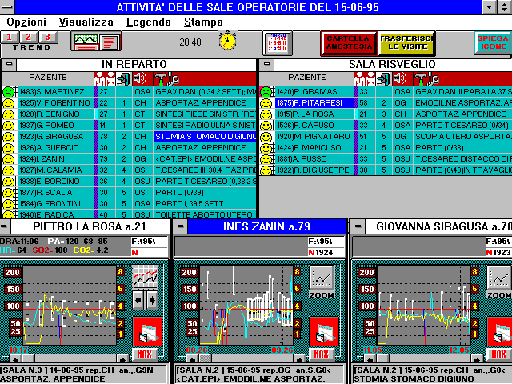 |
Finally in
1993 the anaesthesia network has been improved with a
remote control supervisor feature (fig.7). All the staff
activity is monitored on line. At any workstation (e.g.
chairman's office) it is possible to display any
anaesthetic procedures in progress. |
The patient is represented with a
smiling or a sad coloured small face according to his status:
scheduled , premedicated , during surgery , during recovery ,
discharged
A small sign signals the patients
undergoing emergency procedures . Furthermore, patient's trend
can be displayed and analyzed (fig.7,down).
TECHNICAL REFERENCES
10 anaesthesia workstations and 2
portable PC are using in the B.L.F.H. anaesthesia department. The
10 workstations are networked by a Ethernet LAN (10 Mbits). The
workstation computers are Olivetti 486 DX2 66Mhz 8Mb RAM . An
Olivetti 486 DX 100Mhz 16Mb ram 1200Mb hard disk computer is
utilized as dedicated server. The portable computers are two
Olivetti 386sx 25. Seven workstations are placed in the operating
rooms. The others are situated in the recovery room and at the
chairman's office.
Any PC workstation is able to
display a complete anaesthesiological record and to analyze the
ECG, NIBP CO2 SO2 invasive PA trend . A patient record needs
7942 Kb for the text data and needs 9607 Kb for the vital signals
trend. The remote control supervisor program (RCSP) is able to
perform automatic data collection from monitoring devices,
building an on line trend with a minute to minute resolution, for
any patient. It is possible to display on line trends progress of
6 patients simultaneously. The update interval range is user
programmable from 1 to 60 minutes. It is also possible to
retrieve and to analyse previous activity (trends, surgery list ,etc.),
stored in a server's database. A modem connection is provided at
the chairman office workstation. The modem provides displays of
above mentioned frames at remote locations by phone line,
providing support for on line control or consultations with
remotely logged-in anaesthesiologist by interactive computer
dialogue.
The software written with
Microsoft Visual Basic 3.0 language uses a SQL database that runs
on a Microsoft Open Database Connectivity (ODBC) server.
2 databases are created :
-The first one, updated every
minute by the LAN workstations , contains the table of the
current anaesthesia activity in progress.
-The second one stores the table
of previous anaesthetic activities.
The modem remote control runs
under Carbon Copy for Windows V.2.0 and it is called from RCSP by
dynamic data exchange (DDE).
RESULTS
19189 patient records are on line
available. 3500 records are processed for year.The workstation
are used by all anaesthesiologists and nurses.
 |
FIGURE 8
The figure shows the trend
of the processed records for year and the number of the
users.The priming course to utilize the software is long
a month.
|
The use of the workstation
improved the number of the out-patients visits up 40-50 every
week . In particular, the use of workstation allows us to spreed
the peridural analgesia during the labour. In fact the pregnant
performs an anaesthesiological visit a month before delivery.
This visit is transferred to the network.When the pregnant enters
to the Hospital for the labour this visit is retrieved. The
anaesthesist is able to consult the preoperative visit by the
network and so he can draw as more informations as possible to
perform epidural anaesthesia.
At present in the B.L.F.H. ,every
year, 1000 delivery are treated with epidural anaesthesia.
Furthermore the RCSP allows for an
automatic continuous update of the hospital anaesthetic
activities. Like an airport control panel that displays flies and
passenger status, an anesthesia workstation running the RCSP
displays current patient status and anaesthesiologist activities.
Furthermore the RCPS displaying the surgery progress contributes
to the improvement of the OR working processes allowing for
optimisation of the patient's turnover. The supervisor
anaesthesiologist can prevent mistakes during anaesthetic
procedures and help an inexperienced anaesthesiologist
controlling patient trends and using the pop-up mail. In
conclusion the introduction of the computer in the anaesthetic
activity improves the patient care because it is possible a total
control of the patients management steps.
return to
Department of Anesthesia - Ospedale Buccheri La Ferla
return to ANESTIT







